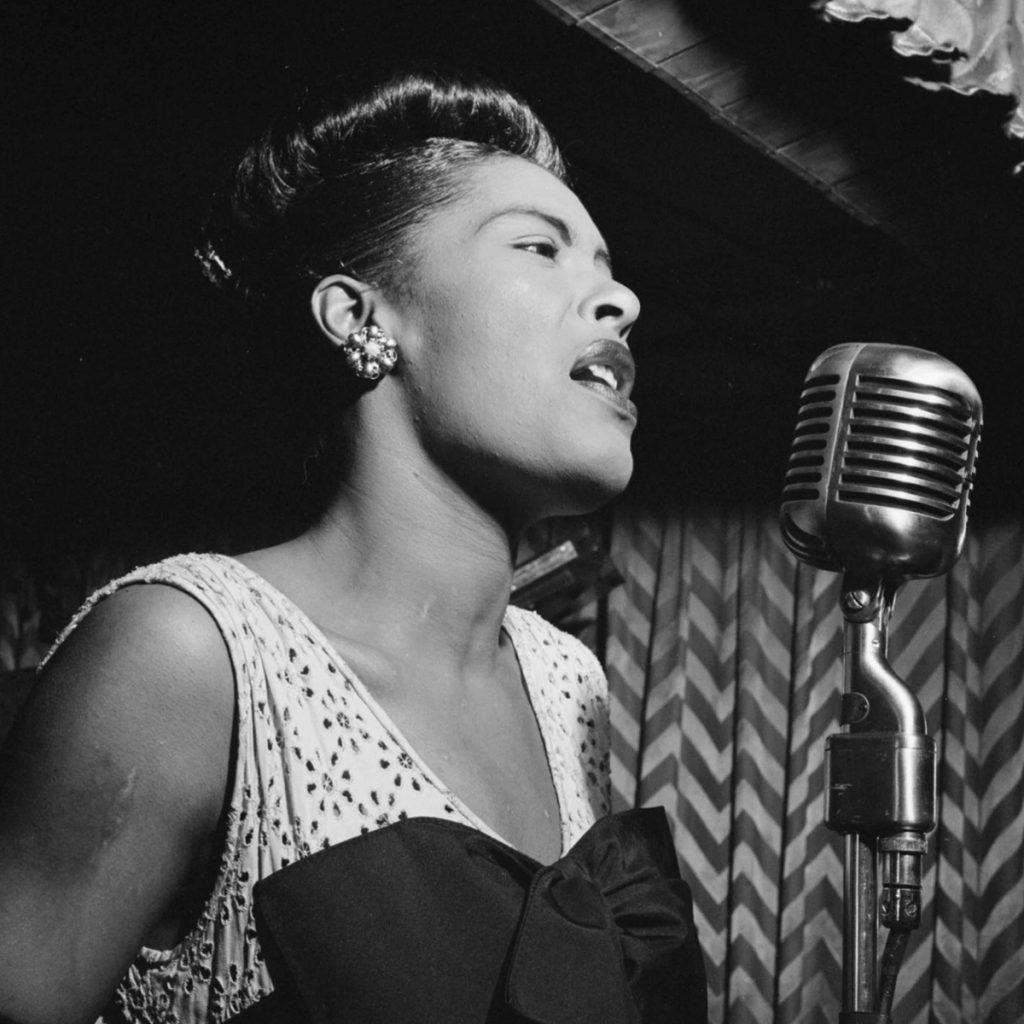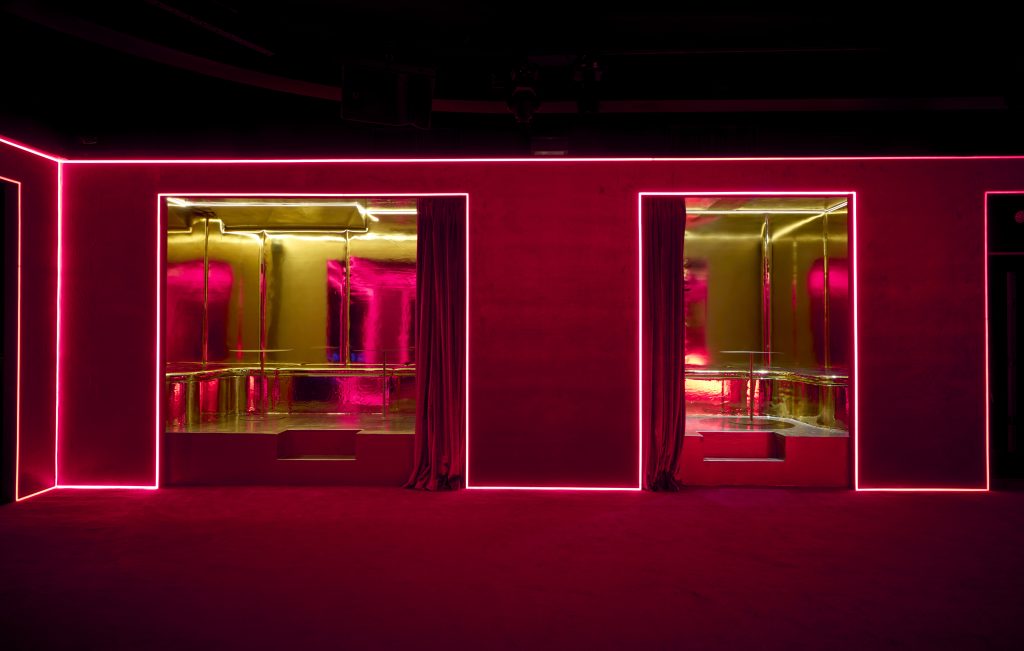Interview: Orly Genger
The artist behind the Madison Square Park installation “Red, Yellow and Blue”

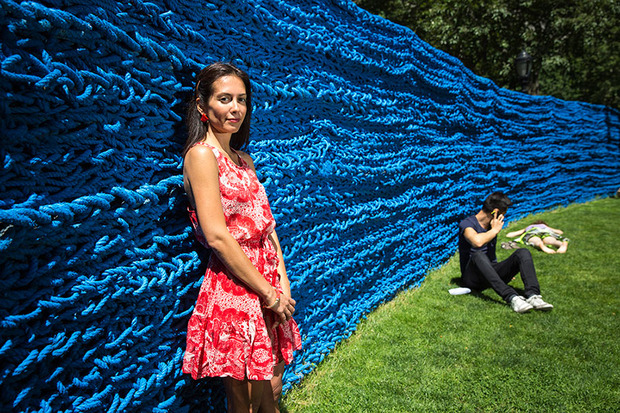
It’s been two months since “Red, Yellow and Blue” opened in NYC at Madison Square Park, and every day it continues to leave a gaze-worthy impression on passerby who are unsure how to approach the spilled, towering waves of vivid primary colors. Onlookers would be surprised to discover that the artist is often observing from only a few feet away.
New York-based sculptor Orly Genger has become known for her use of patterned hand-knotting techniques to build large-scale work, in both interior and exterior spaces. Although she has worked in a wide range of mediums, including cast bronze for her recent 2013 installation “Iron Maiden” at Larissa Goldston Gallery, Genger’s most stunning productions are made from a seemingly simple pairing of rope and paint—albeit large amounts of it. Her manipulation of the material into massive forms explores physicality and space, as her pieces will often alter and reconstruct the very space its exhibited in, and provokes visitors into engaging with the work.
With the installation soon bound for Massachusetts, we checked in with the artist to review her past few weeks. On a bench in Madison Square Park, the sculptor discussed the future of “Red, Yellow and Blue,” her fascination with the body and working with her hands and translating her large-scale works into jewelry—pausing more than once to wave hello at park workers who have grown accustomed to her regular visits.
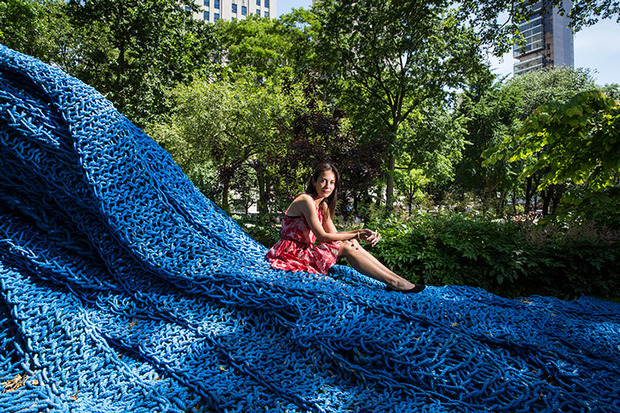
Since your piece opened at the end of May, what is it like revisiting and seeing it from a public context? What have the reactions to “Red, Yellow and Blue” been like?
When the show first opened, I would visit frequently, almost every day. Now I visit maybe once a week, walking through and looking. First of all, just checking the work out and making sure everything is still standing. It still feels like I’m very much involved with it, in the sense that I just want to make sure it’s the way… it’s a process of letting go.
One of the most exciting parts is coming back and seeing people’s reactions and people interacting with the work. The most common reaction that I’ve noticed is people’s immediate desire to touch the work. Also taking pictures with their phones, a lot of selfies by “Yellow” in particular. When we first opened the lawns, there was so much climbing going on that they needed to put up the “No Climbing” signs. I don’t like the fact that the signs are there but it was becoming a safety issue; the art can’t really get that hurt by people. There was a woman who climbed to the top of “Red” and wanted to jump off. So the park was a little concerned.
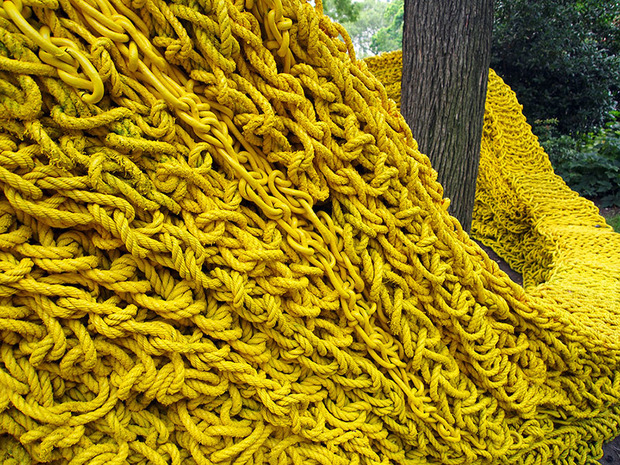
Many people seem to react by asking, “How did a woman do this?”
It’s funny, the guys who work at the park hear people speaking and said to me that a lot of times, people ask them the name of the artist, and they make it clear that they think it’s a man. Fernando, who works here, tells me that he says “It’s a woman—and she’s very small.” It’s funny, I guess because of the size people just assume.
How long did it take to create “Red, Yellow, and Blue”?
It was a two and a half year period. In terms of general massiveness, this is by far the largest piece I’ve made. There was a collection process which took a while; it’s 1.4 million feet of used lobster rope. So the rope arrived at my studio on these pallets and really big boxes, usually fresh from the ocean, so it was wet. Fish scales and lobster claws. In the winter, it would come frozen so we’d have to thaw it out just to get to the point that we could handle it. Then the process of knotting started—knotting all day long, then at nighttime, priming and painting. Towards the end, when it became very intensive, it was knotting for five to seven hours and then painting. It’s the same latex paint you use to paint a house, so most of the wear and tear on the color comes from people sitting on it and not the weather.
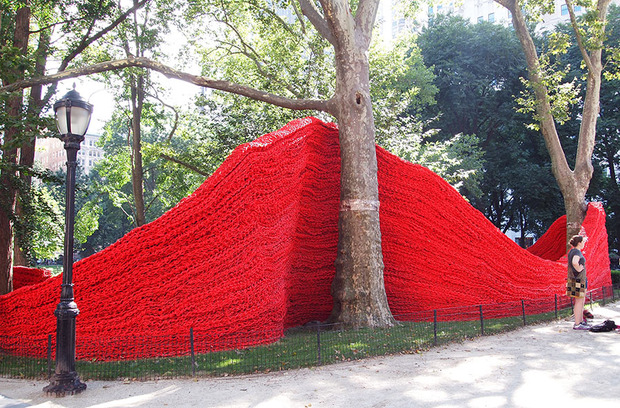
How do you plan your projects?
Usually the way I start is, I’ll take photographs of the space (if it’s a large-scale piece like this), draw on top of it and do Photoshop renderings. I’m always amazed—surprised really—at how much the pieces end up looking like the Photoshop renderings because I always think it’s not really going to look like that, and then it does. I’m a huge planner; that’s why I started on this two and a half years ago. I knew that the work needed that time to be made. It was a very organized process: I had planned out a schedule, what needed to happen by when, and it was never chaotic in the studio. Every artist again is different, but that’s the way I work. I don’t like to be working frantically last minute, it’s not me. In fact, I think I finished “Red, Yellow, and Blue” two weeks early.
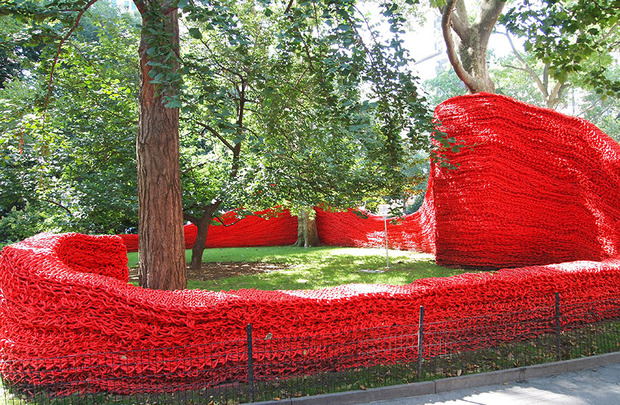
You recycled an older piece from 2010, “Big Boss,” into this installation. What will the future of “Red, Yellow and Blue” be? How do you view the permanence of your sculpture work?
It will be up at the deCordova Sculpture Park and Museum for a year. I will be installing it in a different way. It’s a totally different landscape over there, it’s much hillier. The ground here is really flat; there they have a lot more curves on the landscape so I’ll be playing with that a bit. Here, one of the intentions was to create spaces for people to be in, and there, I don’t think that will be the case. I think it’ll be much more, kind of a meandering-along-the-landscape kind of feeling.
After its showing at the deCordova it might travel to another location. I hope it will find a permanent home someday. But I’m also really interested in the idea of continually reconfiguring the piece for new sites. It allows for the work to have a life that is more dynamic, to continue revealing new sides of it.
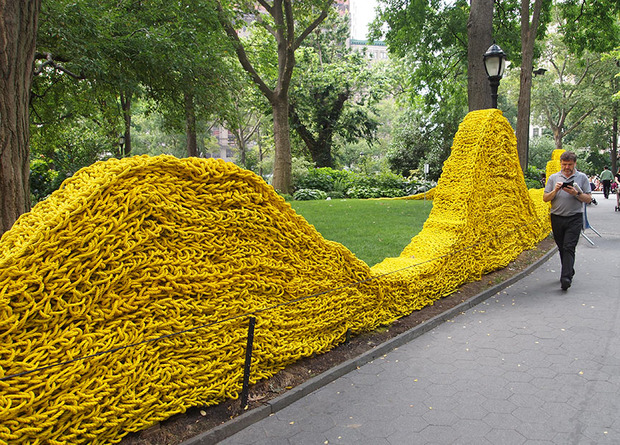
Are you currently working on any side projects?
I’ve been collaborating with the jewelry designer Jaclyn Mayer for maybe three years now. We make jewelry that’s all inspired one way or another by the work that’s going on in the studio. We always relate it to the rope, or make references to it. We made a really small capsule collection that’s red, yellow, and blue.
[This collaboration] kind of happened by chance. She’s a jewelry designer and I was about to open a show at the Indianapolis Museum and I asked her to bring over some of her jewelry so I could wear it to my opening. So she came over to my studio and we started playing around with the material and we made a necklace, and it was totally just for fun. But people really liked it and that’s how it started. It became a real thing.
Why jewelry?
Probably most of my work that people would know is very large-scale. Jewelry always references the body somehow, because there’s a reference to the process of making it—a very physical process. It’s interesting to be able to reference the body in a very direct way, on another scale. I think with the large-scale pieces, they’re meant to be interactive but there’s always kind of the question of ‘who’s wearing who.’ Are you wearing the sculpture or is the sculpture wearing you? The jewelry is another sort of outlet for that.

What was your art education like?
I was working in different materials, plaster and found objects, while I was at Brown University. It was very formal work, and for me that was a very liberating time period where I felt safe enough to really explore. That’s why Brown was really good for me, just very nurturing and let me kind of get dirty and experiment without worrying. I think school is good like that for people because you’re not out yet in the public and you constantly have a group of people there to talk things through… After Brown, I went to the Art Institute of Chicago and did a post-baccalaureate there just for one year. I came back to New York after that and started my Masters at SVA [School of Visual Arts] but I quit after my first semester so that was the end of it. One of the hardest things after school and getting my own studio was realizing that there was no one there to talk to and talk things over with. You kind of had to trust yourself for a while, which is a very frightening thing in the beginning. But then you get used to it!
“Red, Yellow and Blue” is on view daily until 8 Sept 2013 in Madison Square Park, and will then travel to the deCordova Sculpture Park and Museum in Lincoln, MA where it will stay for a year.
Portraits courtesy of Natan Dvir, installation images by Nara Shin
